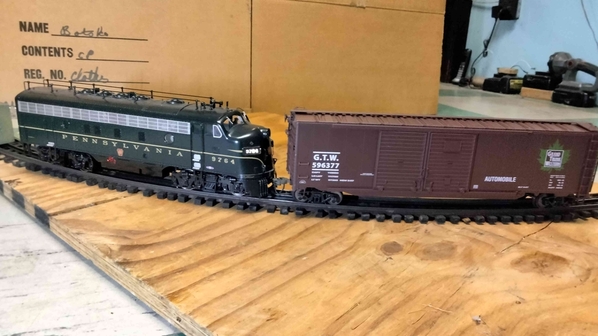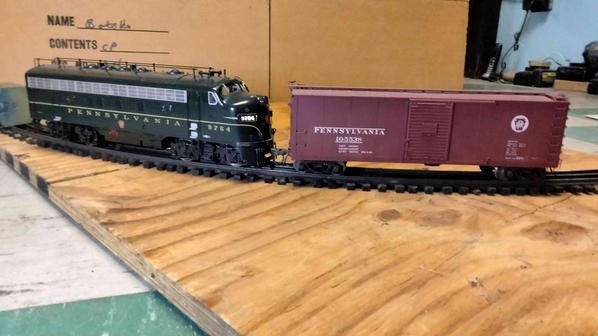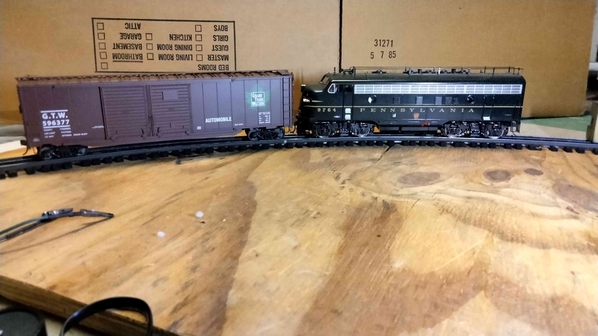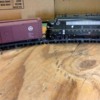Question, What is the minimum radius curve you would run these on without them looking toylike. I am thinking of using 40.5 curves.
Replies sorted oldest to newest
The three rail versions run on a 27" radius, but with the shorter length of the Kadee coupler and the scale opening in the pilot, I would think that they should be able to do a 36" radius. However, my information is anecdotal at best and based on looking at mine. They definitely do well on a 48" radius or better.
I am embarrassed to admit that I have lots of 2 rail Sunset diesels that have yet to see a future layout yet.![]()
@wolf4ever posted:Question, What is the minimum radius curve you would run these on without them looking toylike. I am thinking of using 40.5 curves.
What are "40.5 curves"? Do you mean a RADIUS of "40.5"? If so, that may be a bit tight for those units.
yes, 40.5 inch radius, which is a 6.75 foot diamater curve!
@GG1 4877 posted:The three rail versions run on a 27" radius, but with the shorter length of the Kadee coupler and the scale opening in the pilot, I would think that they should be able to do a 36" radius. However, my information is anecdotal at best and based on looking at mine. They definitely do well on a 48" radius or better.
I am embarrassed to admit that I have lots of 2 rail Sunset diesels that have yet to see a future layout yet.
I am in the same boat. Came from Garden scale! Have been gathering alot of locomotives!
@wolf4ever posted:I am in the same boat. Came from Garden scale! Have been gathering alot of locomotives!
![]()
![]() Yes. I am planning on minimum 48" radius curves to be on the safe side. Only then that will be for my dedicated freight and yard tracks. Otherwise I'm going with the manufacturer suggested 54" radius.
Yes. I am planning on minimum 48" radius curves to be on the safe side. Only then that will be for my dedicated freight and yard tracks. Otherwise I'm going with the manufacturer suggested 54" radius.
My two cents. Will you be running freight or passenger trains? If your only modeling freight, plan for at least 50” radius. If it’s passenger, plan for at least 70”. The F units will run on those radiuses, the rest of the train may not.
Are we talking radius or diamater. 48inch radius is a 8 foot dimater curve! Just making sure.
@wolf4ever posted:Are we talking radius or diamater. 48inch radius is a 8 foot dimater curve! Just making sure.
Yes. 48" radius or 96" diameter.
A point to make, full length GGD passenger cars have no issues running on 54” radius curves. Of course the larger the radius the better they look. Layout design in most cases entails making a series compromises. I’m on my 4th O scale layout and have a good sized basement. My first priority was interesting operation that followed elements of prototype practice - to achieve that end I went with 60” radius on the latest railroad. I recommend reading John Armstrong’s Track Planning for Realistic Operation as food for thought in making tradeoffs between appearance and operation.
@Keystoned Ed posted:A point to make, full length GGD passenger cars have no issues running on 54” radius curves. Of course the larger the radius the better they look. Layout design in most cases entails making a series compromises. I’m on my 4th O scale layout and have a good sized basement. My first priority was interesting operation that followed elements of prototype practice - to achieve that end I went with 60” radius on the latest railroad. I recommend reading John Armstrong’s Track Planning for Realistic Operation as food for thought in making tradeoffs between appearance and operation.
come on Ed. Most of us mortals won't ever have a RR like yours. Now you want us to learn? ![]()
starting around 1:11:03 into the video...
My layout space is 15 x 43
I use 52 inch radius for my mainline and 48 inch on the branch line. I did that to accomodate a Max Grey 2-10-4 that says it wants 54 inch radius but will handle the 52. Also I had track curve templates given me for 48, 52, 56, 60 and a few others.
I would not use the tighter radius or smaller than #6 switches in yards where you do a lot of pushing. This will tend to cause unreliable operation and lead to derailments unless strings are very short.
As Ed mentioned the GGD cars have no problems. They run fine on 52 and 48 inch radius for me.
I have a bunch of USH, MG, sunset, PRR steam prototype locos such as L1, I1, K4, E6, N1, M1, M1A and they will all go around 48 inch radius with no problems. The smaller B6, H6, H10 etc obvioiusly can handle it. All the 4 axle diesels I have plus Atlas RD7 and Sunst SD9 6 axle units have no problem with 48 inch radius curves.
The first issue I think you run into with diesel models on sharp curves is coupler connections. I think the locos will go around a curve much sharper than the standard KAdee box will support. As the curves get sharper the couplers move farther to the outside of the curve until they can no long connect with the cars on the track. You can mount the couplers without boxes as in streetcars and get them to work on sharper curves.
So operation is not problem. I think many of the 4 axle diesels could easily go down to 40 inch radius. Appearance is a totally different issue. That is in the eyes of the beholder. In other words if you don't like it, it doesn't work and if you are OK with the look, it does work.
In my opinion looking at the stuff on sharp curves from inside is much better. They don't look nearly as bad as looking at them from outside of the curve. So around the walls works better. I model the 40s or the early 60s (steam or diesel ops) and I have stuck with 40-50 cars. I don't have any modern 70 80 ft freight cars. I do have some 80 ft passenger cars from GGD.
My final thought, is lay a half dozen sections of your track, and set the locos on it and see whether YOU like it or not.
@prrjim posted:In other words if you don't like it, it doesn't work and if you are OK with the look, it does work....
...My final thought, is lay a half dozen sections of your track, and set the locos on it and see whether YOU like it or not.
There it is...in a nutshell.
Mark in Oregon
Or we could just say: Make it as large as possible and live with it,
ECI
PS: Happy New Year!
You won’t have any issue with F7’s on 40.5” radiuses. I have a friend who’s minimum is 36” due to space constraints and he runs F units, Geeps, and even small steam.
On my layout, my mainline minimum is 54” and my coal branch is 50”. I can run just about anything (I mostly run all steam). GGD passenger equipment has no issues on those radiuses.
My F7s and F3s had no issues on 36"r. FWIW, I just tested my new GP9 on 24"r and it worked just fine.
I found an old piece of Gargraves flex track that has flattop rail so small flange 2 rail type wheels work fine in out. I curved it to 36 inch radius. It is not a smooth curve because the track is old and does not curve easily, but it matches my 36 in template quite well. This track has wooden ties so it can be powered for 2 rail.
I did 3 tests. First I ran my 2 rail F7 loco back and forth on the curve and it ran fine and all the sounds worked. It would creep easily and didn't mind the kinks. I am totally convinced it will run on 36 inch radius with no issues.
second, I hooked it up to a 40 ft boxcar. Both the loco and the boxcar have standard kadee couplers in Kadee boxes. I wanted to check appearance and if the couplers would mate on the curve. I took a photo of the car and loco from the inside and the outside of the curve, so you can see how it looks. There is an overhang on the inside of the curve. The couplers fit each other well on the curve with no issues.
Third, I hooked it up to a 50 ft boxcar. Both the loco and the boxcar have standard kadee couplers in Kadee boxes. I wanted to check appearance and if the couplers would mate on the curve. I took a photo of the car and loco from the inside and the outside of the curve, so you can see how it looks. There is a significant overhang on the inside. The couplers fit each other well on the curve with no issues.
So to summarize, the Sunset GGD F7 will run on 36 inch radius curves and will couple and work with 50 ft and smaller cars with Kadee couplers installed without modification. This means the Sunset GGD F3 will probably do as well since it is the same size as the F7.
the Appearance is personal choice. I would do it if my space required.











